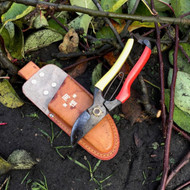What’s worse than finding a maggot in your apple? Answer – finding half a maggot!
Dad jokes aside, it is so disappointing to wait all summer and watch your fruit ripen, only to find them inedible when you bite into them. Codling moth (and the related plum maggot moth, which affects plums and gages) can be a serious pest, but the good news is that there are some easy ways to combat them. The female codling moth lays her eggs in late spring, and when hatched the larvae burrow into the fruitlets in May and June.
There is quite a short window of opportunity to spray any contact insecticide before the caterpillars are hidden away inside the fruit, so ideally we need some sort of warning sign. This is where a pheromone trap can come in extremely useful – they emit the scent of the female moth and catch males whose interest has been piqued. Hang a couple among your apple trees in May and see if you collect any males. If you start to see several males in there per week, it is probably worth using a fruit-and vegetable-approved contact insecticide around the middle of June to control the caterpillars before they burrow into your fruit. Catching males also has the benefit of the amorous intentions of the females going unrequited, so fewer fertile eggs will be laid.
Winter moths can also be a serious pest, as the caterpillars can nibble on young foliage, blossom and fruitlets, which can cause significant damage and reduce crops. Here, the life cycle is different – the female moth (who is wingless) climbs the tree in autumn and early spring to lay eggs. These then hatch, and the larvae emerge and start feeding on your precious fruit trees – a bad infestation can seriously weaken a tree.

A physical barrier which prevents the female from climbing the tree in the first place will work, and for this we need to have grease bands on all top fruit trees. These are bands of greaseproof paper topped with a layer of sticky grease, which can be cut to size and tied around the main trunk. Put them on (or renew) every autumn, and you should stop any damage from these moths. As a bonus, they also stop ants crawling up the tree too – ants are well-known to ‘farm’ aphids in spring, protecting them from predators in return for the sticky sweet honeydew the aphids produce.
If you have old trees where the bark is rough and fissured, it may be impossible to get a suitably tight fit, so instead you can buy pots of fruit tree grease and simply smear a 10cm (4in) band around the trunk, 60cm (2ft) or so above soil.
Winter pruning – apples and pears.
Annual winter pruning is one of the most important jobs for anyone growing apple or pear trees, and for several reasons:
- It helps form a sturdy tree. Formative pruning makes sure the tree is evenly balanced, with a strong framework of branches which will not break easily in wind or cause the tree to topple.
- It helps ensure a healthy tree. Removing dead or diseased branches removes potentially fatal sources of infection, and opening up air circulation reduces the risk of fungal diseases.
- It promotes a fruitful tree. Regular pruning helps encourage the production of fruiting spurs, as well as allowing better sunlight penetration to improve fruit ripening.
- Finally, and possibly most importantly, it keeps the size of the tree under control.
Winter Pruning, the basics:
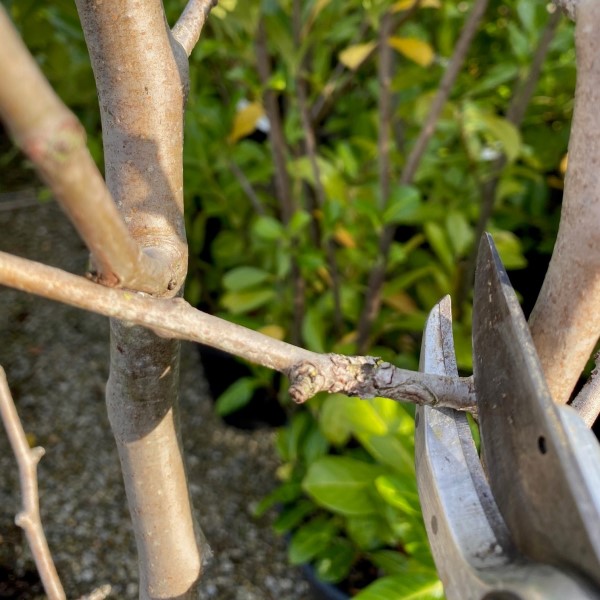
1 Prune out dead, diseased or damaged wood. Normally you would do this as part of your winter prune, but can actually be done at any time of year. In fact, it is best to do this as soon as you notice the damage, so if you spot a little canker on the branches, or a limb has been broken in high winds, prune back to a healthy branch or bud as soon as you can. Damaged branches are one of the main entry routes for diseases such as canker, so clean them up and help protect your tree.
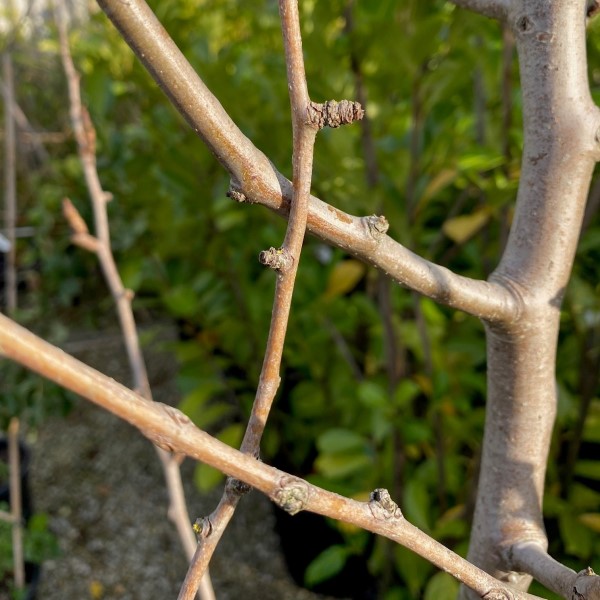
2 Remove any branches which are crossing and rubbing. Not only will the bark become damaged, allowing disease to enter, but it is also a sign of congested growth. Thinning branches out will give better air circulation and improve the health of the tree and the quality of the crop.
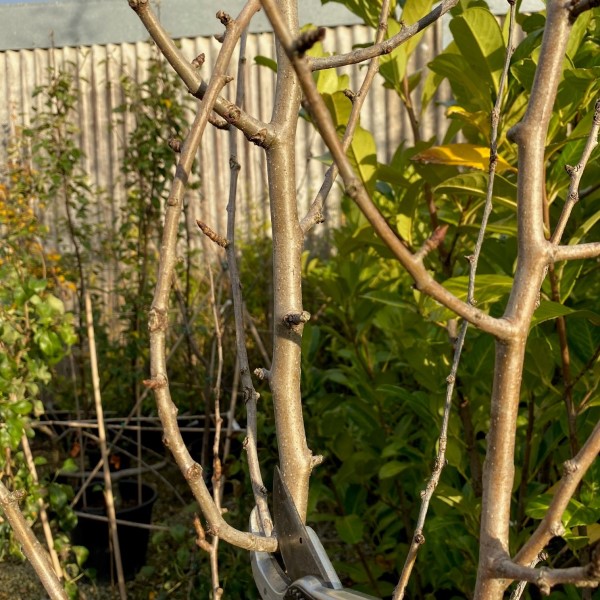
3 Remove any branches growing into the centre of the tree. For most fruit trees, we are aiming for a nice open centre, almost like a wine glass. This again allows better air circulation and sunlight to get to all the fruit. Young pear trees in particular are prone to growing in a narrow, upright fashion until they broaden out with age, so for pears this step is probably the most important.
Remember, winter pruning is ONLY for apple and pear trees. Don’t touch any of the stone fruit (plums, gages, cherries, etc) as you greatly increase the risk of canker or silverleaf spores carried in winter rain entering the pruning cuts.
Winter wash.
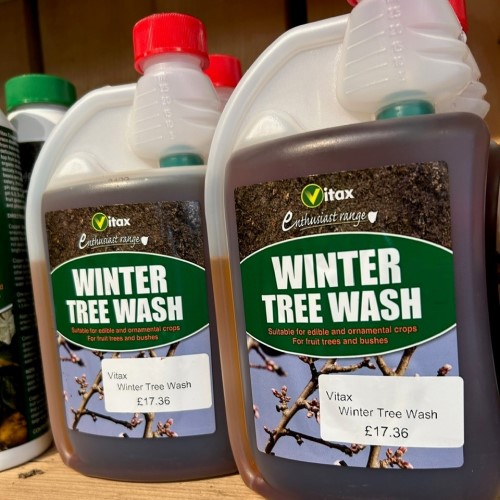
Alongside pruning, giving your trees a winter wash is probably the most beneficial task you can carry out. Most pests and diseases have a life cycle, which means the problem will keep re-occurring unless you break that cycle. A winter wash of a mild disinfectant does just that, killing overwintering fungal spores and insect eggs to make sure your trees have a clean start in the spring.
Most garden centres or online retailers will have a selection of fruit tree winter wash concentrates – simply dilute as per the instructions and then use a hand sprayer to liberally wet every branch that you can reach. Normally this is a job I like to do after I’ve done any pruning, as it helps clean the pruning cuts.
Don’t fret if you have a 7-metre-tall Bramley and can’t reach all the branches, just do the bits you can get too. As with pruning, it’s often a compromise between the ideal and what is physically possible and anything you can do will help.
Soft Fruit.
Less to do in the winter for soft fruit – unless you missed out on any jobs that could or should have been done in the autumn…
Raspberries – prune back all canes of autumn-fruiting varieties to 1cm above soil level. For summer-fruiting types, you want to leave the new growth to provide fruit for next year, but prune out any canes that bore fruit last summer. If the new canes have got very tall, you can take the top 30-50cm off, which will encourage them to produce small side shoots which will bear fruit next year.
Blackcurrants fruit best on one year old wood, so we are constantly pruning out stems which have fruited to leave new growth for the following year’s crop. I find it’s much easier to prune the stems with the fruit on them in summer, and pick the fruit in comfort at the kitchen table, but if you haven’t prune out the old wood, its time to do so. It stops the plant getting too congested with unproductive wood, and reduces the chances of mildew next year.
Red currants, white currants and gooseberries can also be pruned in the winter. They fruit on old wood, so here you are just looking to think out growth to try and get that textbook ‘wine glass’ shape, with an open centre. Gooseberries in particular benefit from a winter prune, taking out or shortening any branches which are crossing or growing into the centre of the plant. Better air circulation means less chance of the dreaded American Gooseberry mildew.

